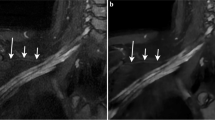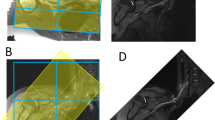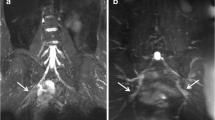Abstract
Objective
To evaluate the impact of deep learning (DL) reconstruction in enhancing image quality and nerve conspicuity in LSP MRN using DESS sequences. Additionally, a geometric image combination (GIC) method to improve DESS signals’ combination was proposed.
Materials and methods
Adult patients undergoing 3.0 Tesla LSP MRN with DESS were prospectively enrolled. The 3D DESS echoes were separately reconstructed with and without DL and DL-GIC combined reconstructions. In a subset of patients, 3D T2-weighted short tau inversion recovery (STIR-T2w) sequences were also acquired. Three radiologists rated 4 image stacks (‘DESS S2’, ‘DESS S2 DL’, ‘DESS GIC DL’ and ‘STIR-T2w DL’) for bulk motion, vascular suppression, nerve fascicular architecture, and overall nerve conspicuity. Relative SNR, nerve-to-muscle, -fat, and -vessel contrast ratios were measured. Statistical analysis included ANOVA and Wilcoxon signed-rank tests. p < 0.05 was considered statistically significant.
Results
Forty patients (22 females; mean age = 48.6 ± 18.5 years) were enrolled. Quantitatively, ‘DESS GIC DL’ demonstrated superior relative SNR (p < 0.001), while ‘DESS S2 DL’ exhibited superior nerve-to-background contrast ratio (p value range: 0.002 to < 0.001). Qualitatively, DESS provided superior vascular suppression and depiction of sciatic nerve fascicular architecture but more bulk motion as compared to ‘STIR-T2w DL’. ‘DESS GIC DL’ demonstrated better nerve visualization for several smaller, distal nerve segments than ‘DESS S2 DL’ and ‘STIR-T2w DL’.
Conclusion
Application of a DL reconstruction with geometric image combination in DESS MRN improves nerve conspicuity of the LSP, especially for its smaller branch nerves.





Similar content being viewed by others
Data availability
The raw data used to support the findings of this study are available upon reasonable request from the corresponding author.
Abbreviations
- MRN:
-
Magnetic resonance neurography
- LSP:
-
Lumbosacral plexus
- STIR-T2w:
-
T2-weighted short tau inversion recovery
- DESS:
-
Dual-echo steady-state
- SSFP:
-
Steady-state free precession
- SNR:
-
Signal-to-noise ratio
- DL:
-
Deep learning
References
Chhabra A, Kanchustambham P, Mogharrabi B, Ratakonda R, Gill K, Xi Y. MR Neurography of Lumbosacral Plexus: Incremental Value Over XR, CT, and MRI of L Spine With Improved Outcomes in Patients With Radiculopathy and Failed Back Surgery Syndrome. J Magn Reson Imaging. 2023;57:139–50.
Chhabra A, Rozen S, Scott K. Three-Dimensional MR Neurography of the Lumbosacral Plexus. Semin Musculoskel R. 2015;19:149–59.
Sims GC, Boothe E, Joodi R, Chhabra A. 3D MR Neurography of the Lumbosacral Plexus: Obtaining Optimal Images for Selective Longitudinal Nerve Depiction. Am J Neuroradiol. 2016;37:2158–62.
Kasper JM, Wadhwa V, Scott KM, Rozen S, Xi Y, Chhabra A. SHINKEI—a novel 3D isotropic MR neurography technique: technical advantages over 3DIRTSE-based imaging. Eur Radiol. 2015;25:1672–7.
Zhang Y, Kong X, Zhao Q, Liu X, Gu Y, Xu L. Enhanced MR neurography of the lumbosacral plexus with robust vascular suppression and improved delineation of its small branches. Eur J Radiol. 2020;129:109128.
Redpath TW, Jones RA. FADE–A new fast imaging sequence. Magn Reson Med. 1988;6:224–34.
Hu S, Li Y, Hou B, Zhang Y, Liu WV, Wu G, et al. Multi-echo in steady-state acquisition improves MRI image quality and lumbosacral radiculopathy diagnosis efficacy compared with T2 fast spin-echo sequence. Neuroradiology. 2023;65:969–77.
Hardy PA, Recht MP, Piraino D, Thomasson D. Optimization of a dual echo in the steady state (DESS) free-precession sequence for imaging cartilage. J Magn Reson Imaging. 1996;6:329–35.
Zochowski KC, Tan ET, Argentieri EC, Lin B, Burge AJ, Queler SC, et al. Improvement of peripheral nerve visualization using a deep learning-based MR reconstruction algorithm. Magn Reson Imaging. 2022;85:186–92.
Kim M, Kim HS, Kim HJ, Park JE, Park SY, Kim Y-H, et al. Thin-Slice Pituitary MRI with Deep Learning–based Reconstruction: Diagnostic Performance in a Postoperative Setting. Radiology. 2021;298:114–22.
Herrmann J, Koerzdoerfer G, Nickel D, Mostapha M, Nadar M, Gassenmaier S, et al. Feasibility and Implementation of a Deep Learning MR Reconstruction for TSE Sequences in Musculoskeletal Imaging. Diagnostics. 2021;11:1484.
Ensle F, Kaniewska M, Tiessen A, Lohezic M, Getzmann JM, Guggenberger R. Diagnostic performance of deep learning–based reconstruction algorithm in 3D MR neurography. Skelet Radiol. 2023;52(12):2409–18.
Lebel RM. Performance characterization of a novel deep learning-based MR image reconstruction pipeline. 2020. https://arxiv.org/abs/2008.06559.
Sun S, Tan ET, Mintz DN, Sahr M, Endo Y, Nguyen J, et al. Evaluation of deep learning reconstructed high-resolution 3D lumbar spine MRI. Eur Radiol. 2022;32:6167–77.
Queler SC, Tan ET, Geannette C, Prince M, Sneag DB. Ferumoxytol-enhanced vascular suppression in magnetic resonance neurography. Skeletal Radiol. 2021;50:2255–66.
Delaney H, Bencardino J, Rosenberg ZS. Magnetic Resonance Neurography of the Pelvis and Lumbosacral Plexus. Neuroimag Clin N Am. 2014;24:127–50.
Sneag DB, Daniels SP, Geannette C, Queler SC, Lin BQ, de Silva C, et al. Post-Contrast 3D Inversion Recovery Magnetic Resonance Neurography for Evaluation of Branch Nerves of the Brachial Plexus. Eur J Radiol. 2020;132:109304.
Harrell AD, Johnson D, Samet J, Omar IM, Deshmukh S. With or without? A retrospective analysis of intravenous contrast utility in magnetic resonance neurography. Skeletal Radiol. 2020;49:577–84.
Chhabra A, Subhawong TK, Bizzell C, Flammang A, Soldatos T. 3T MR neurography using three-dimensional diffusion-weighted PSIF: technical issues and advantages. Skeletal Radiol. 2011;40:1355–60.
Zhang Z, Meng Q, Chen Y, Li Z, Luo B, Yang Z, et al. 3-T imaging of the cranial nerves using three-dimensional reversed FISP with diffusion-weighted MR sequence. J Magn Reson Imaging. 2008;27:454–8.
Gras V, Farrher E, Grinberg F, Shah NJ. Diffusion-weighted DESS protocol optimization for simultaneous mapping of the mean diffusivity, proton density and relaxation times at 3 Tesla. Magn Reson Med. 2017;78:130–41.
Hwang L, Dessouky R, Xi Y, Amirlak B, Chhabra A. MR Neurography of Greater Occipital Nerve Neuropathy: Initial Experience in Patients with Migraine. Am J Neuroradiol. 2017;38:2203–9.
Acknowledgements
The authors thank Maggie Fung for providing technical advice.
Funding
DBS and ETT acknowledge institutional research support from GE HealthCare.
Author information
Authors and Affiliations
Corresponding author
Ethics declarations
Conflicts of interest
ETT and DBS declare that the geometric image combination technique utilized here is covered under an invention disclosure to the Hospital for Special Surgery.
Additional information
Publisher's note
Springer Nature remains neutral with regard to jurisdictional claims in published maps and institutional affiliations.
Summary statement
3D DESS MRN, enhanced with DL and GIC reconstruction, provides improved visualization and fascicular architecture assessment of the LSP compared to a DL-reconstructed 3D STIR-T2w sequence, particularly for distal, smaller branch nerves.
Key results
• Deep learning (DL) reconstruction improves image quality and nerve contrast in 3D DESS MR neurography, both quantitatively and qualitatively.
• Geometric image combination (GIC) provides superior visualization of several segments of lumbosacral plexus (LSP) nerve branches.
• Utilizing DL and GIC reconstruction in DESS provides superior fat- and vascular suppression, nerve fascicular architecture, and visualization of distal nerve branches compared to DL-reconstructed 3D STIR-T2w for MR neurography of the LSP.
Supplementary Information
Below is the link to the electronic supplementary material.
Rights and permissions
Springer Nature or its licensor (e.g. a society or other partner) holds exclusive rights to this article under a publishing agreement with the author(s) or other rightsholder(s); author self-archiving of the accepted manuscript version of this article is solely governed by the terms of such publishing agreement and applicable law.
About this article
Cite this article
Lin, Y., Tan, E.T., Campbell, G. et al. Improved 3D DESS MR neurography of the lumbosacral plexus with deep learning and geometric image combination reconstruction. Skeletal Radiol (2024). https://doi.org/10.1007/s00256-024-04613-7
Received:
Revised:
Accepted:
Published:
DOI: https://doi.org/10.1007/s00256-024-04613-7




